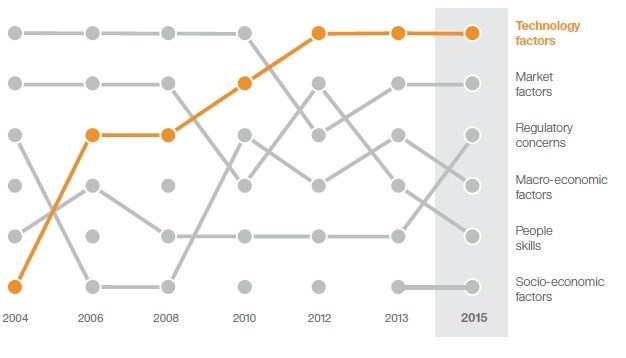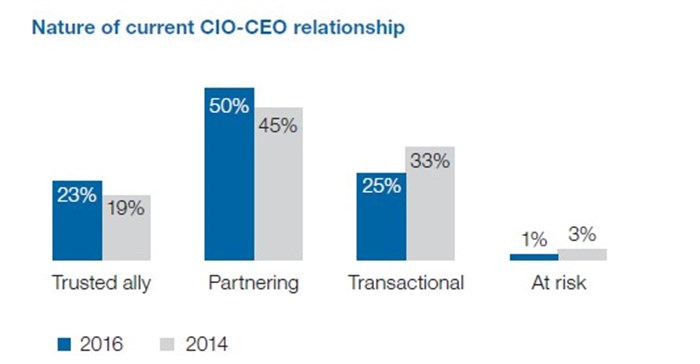SMEs potentially biggest losers of digital disruption
It was an absolutely mind-blowing experience and the best reminder of why every company should embark on a digital transformation or DX journey.
I got the inside track from some of the world’s leading authorities on the current state and future prospects of technologies such as artificial intelligence, 3D printing, autonomous vehicles, sensor networks and virtual reality to name a few.
But then I had to get back to earth and in my case, this means working with SME IT leaders from around the world who participate in our Mastermind groups.
And while facilitating one of these sessions it finally hit me:
The risks and opportunities from digital disruption are not evenly distributed.
In this article, I will show you why I think so by diving into the 4 largest obstacles I see on an almost daily basis when working with IT leaders from small and medium businesses.
Unfortunately, there is no silver bullet to address these challenges (yet), but I will still conclude on a more positive note and give some practical advice on how any organisation can start moving in the right direction.
- The threat of digital disruption is not yet real for most SMEs
By far the biggest issue facing current SMEs is that most of their leaders are still completely oblivious to the threats posed by digital.
And even if they are not, they mostly still work under the dangerous assumption that, as long as they don’t fall behind, they will have enough time to play catch-up as soon as a new operator or threatening business model appears.
And this is exactly how bookstores thought before Amazon, hotel operators before Airbnb, taxi organizations before Uber and, probably how all the horse operators in US cities felt before the automobile completely transformed the way people moved from A to B in just 13 short years, as the next two photos of 5th Avenue in New York highlight so powerfully (also read about Tony Sebas' fascinating perspective on disruption).
The first photo was taken on Easter Morning in 1900 and shows a street full of horses and carriages (Source: US Bureau of Public Roads).

The next photo is taken exactly 13 years later and shows the same street. Can you still spot the carriage amongst all the automobiles?

And then add to this the incredible activity of startup businesses from around the world who are committed to using technology to disrupt absolutely anything you can think of … and if your business happens to serve the customers they are after, then you are fair game.
What is even more unfair (at least from the perspective of SMEs), is that even when large business completely underestimate the disruptive potential of digital technologies, they will probably still have the resources to just buy one or more startups with promising technology and/or pour massive resources into a consultant-led digital transformation to get up to speed fast.
So, the real question becomes, why are many SMEs so slow to recognise the challenges?
The next obstacle may shed some light on this.
- IT is only a support function in most SMEs
Although IT leaders in SMEs sometimes may have very impressive-sounding titles (such as chief information officer or chief technology officer), the truth is that in most instances IT is seen as an enabler and not a strategic contributor.
To test whether this is the case in your organisation, just ask yourself whether your IT leader is present when business strategy and options are discussed at the most senior level?
Yes?
Really? If yes, then consider yourself special (and perhaps lucky) as in most businesses the IT leader is probably the last person who is considered to be a valuable strategic contributor.

And as long as this is true, unfortunately, a business will really struggle to recognise the threats and opportunities presented by our increasingly digital world.
Now let’s shift our focus to larger organisations and compare.
In a 2015 survey of global CEOs, IBM has found that technology ranks as the number-one factor impacting organisations.

In line with this finding, Gartner confirms in its 2016 survey of senior IT leaders that CIOs are increasingly trusted as strategic contributors.

Not to be outdone by large businesses, startups rely so heavily on their technology leaders and competence that they sometimes forget that they also need other role players to build a successful business.
The point I am trying to make is that both startups and large organisations are very aware of the disruptive potential of technology while small and medium businesses often do not even consider IT as a strategic tool.
And even if they do, the next obstacle shows just how difficult it is for SMEs to get good information and guidance on how to start a digital transformation.
- Digital transformation guidance for SMEs is non-existent
Ok, perhaps I am taking it a bit too far by saying it is non-existent.
The SAP Digitalist newsletter and of course the Xuviate blog are two notable exceptions.
But seriously, isn’t it true that digital case-studies and success stories almost always reference large, well-funded organisations (think of Amazon, General Electric, Burberry) or similarly well-funded startups that have managed to gain traction (think of Uber and Airbnb).
And doesn’t matter how often you have heard that small or medium business are just smaller versions of their larger competitors, don’t believe it.
Their situation and challenges are unique and require unique solutions.
While there are undoubtedly good lessons to be learned from the digital journeys of the other two types of organisations, most organisations do not consider themselves innovators or even early adopters and prefer to wait until they see positive returns from companies they consider similar to themselves.

But even the Innovators and Early Adopters in Geoffrey A Moore’s Technology Adoption Lifecycle face a major challenge as they really battle to source relevant outside input.
- The digital ecosystem for SMEs is still in its infancy
I cannot say this enough:
Digitally transforming an organisation should not be confused with a technology point solution.
Instead, it is a journey that involves fundamentally changing how the business runs, what skills are needed to run it and how technology is employed to differentiate the business and delight customers. Unfortunately, supporting such a transformation doesn’t only require occasional input from one vendor but sustained assistance from a multitude of aligned organisations that reinforce each other and help architect the many mindset changes required to truly move forward.
And this is expensive!
No, let me revise for emphasis.
It is extremely expensive and most small and medium businesses simply do not have the resources to engage with the current crop of specialist consulting organisations who are too busy feasting on the opportunities presented by large organisations who are panicking.
Current IT vendors that service the SME market, on the other hand, have been taught by their clients to be super-focused on delivering specific technology skills and have little awareness and ability themselves to lead digital transformation.
Another dead end!
Lastly, turning to the growing number of self-employed consultants we also find that they have great difficulty with building skills in company-wide digital transformations.
Unfortunately for them, there is no ITIL-equivalent standard for digital transformation that could help sell their services and simplify the coordination and collaboration with other service providers.
The conclusion is sobering:
Most SMEs are on their own when it comes to embarking on a digital transformation journey.
Conclusion: Start by creating digital awareness
As digital business models rapidly reduce or nullify the usual small business advantages of proximity, flexibility and cost, these businesses will have to look for other sources of revenue and ultimately have to embark on a journey of digital transformation themselves or risk being left behind.
And unfortunately, as I have tried to show in this article, this is easier said than done and small and medium businesses face some particularly big obstacles along the way.
The biggest obstacle by far, however, is the lack of understanding of the real magnitude and urgency of the problem.
And lucky for SMEs, this problem is self-induced and can be addressed through a concerted effort that ideally should start today.
I have found the following three steps to be very useful for kick-starting digital awareness in any business:
- Start with yourself and make a point of reading up on anything digital. Since every business leader will have to become a technology leader in their own field, you may as well start today. If you are the IT leader, consider joining one of our Mastermind Groups and hear from and learn from others who battle with similar challenges.
- Engage and envision other leaders in your business. Encourage everyone to continuously evaluate how rapidly-evolving technologies could potentially threaten the future of the company. And while doing so, don’t forget to ask how your company could potentially convert these insights into opportunities!
- Experimentation is one of the defining characteristics of any digital company. Familiarise yourself with this agile approach and find a significant, highly visible problem within your organisation that could be solved by applying modern technologies. Then assemble your team, obtain buy-in, design a solution and rapidly iterate towards a solution. Use the Google Ventures Design Sprint for inspiration. There is nothing more important to a successful digital transformation than having an early win and a practical case-study.
With the awareness challenge out of the way, I am convinced that there will finally be enough momentum to figure out how we can overcome the other three challenges.
If you want to be part of this journey I invite you to connect with me on LinkedIn and let me know how we can work together to help SMEs on their digital transformation journey.
Read the original article on the Xuviate blog.









